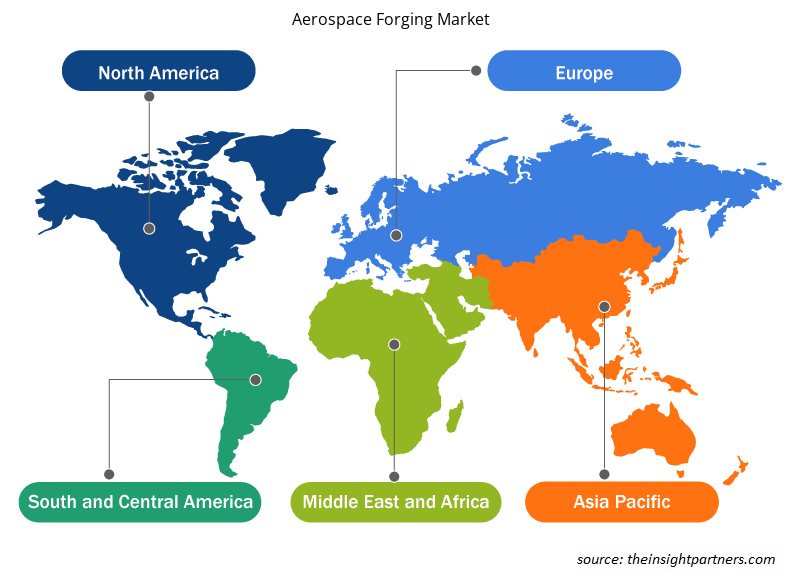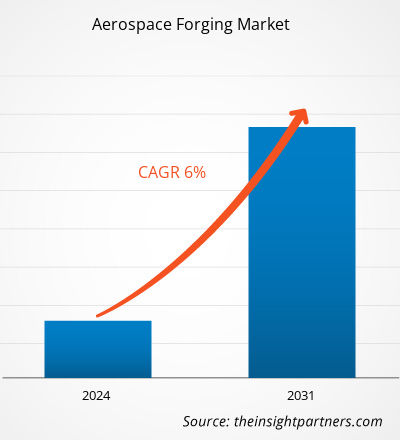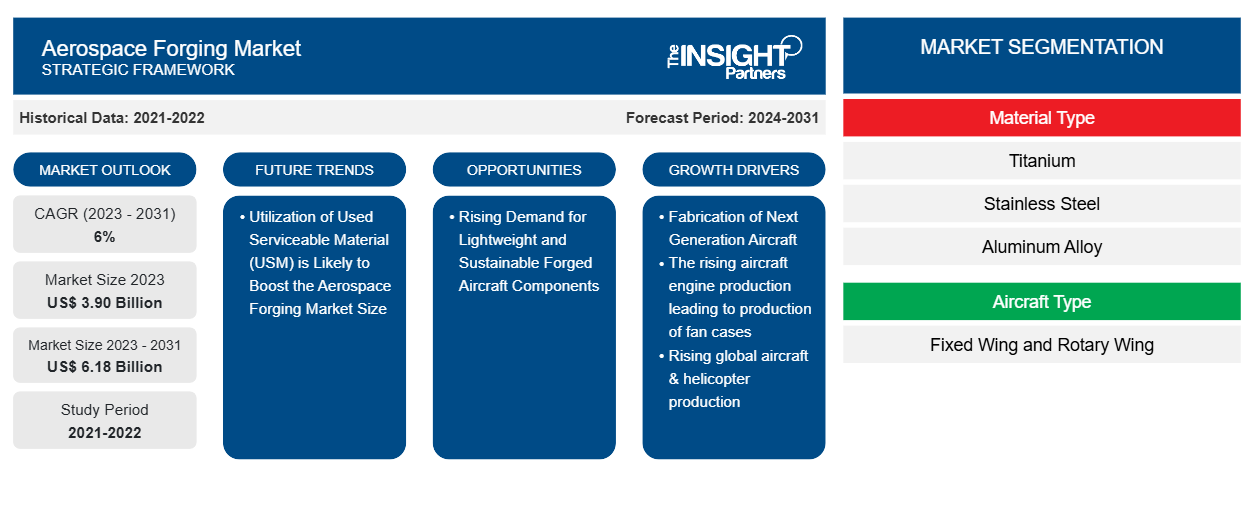Si prevede che la dimensione del mercato della forgiatura aerospaziale raggiungerà i 6,18 miliardi di dollari entro il 2031, rispetto ai 3,90 miliardi di dollari del 2023. Si prevede che il mercato registrerà un CAGR del 6,0% nel 2023-2031.
Il Nord America è un rifugio per oltre il 40% della flotta di elicotteri globale e pertanto prevede di acquistare e sostituire la flotta esistente con una nuova nei prossimi anni. In questo modo, la regione è in grado di soddisfare le esigenze del mercato aerospaziale. Sostituire le flotte esistenti con nuovi elicotteri stimolerà anche il mercato della forgiatura aerospaziale contemporaneamente. Alcune delle aziende coinvolte nel business della produzione e fornitura di motori per aeromobili e prodotti di forgiatura includono The Boeing Company, Patriot Forge Co., Scot Forge, United Technologies Corporation e altre.
Analisi del mercato della forgiatura aerospaziale
È probabile che il mercato della forgiatura aerospaziale assista a una forte crescita nel periodo 2023-2031. Questa domanda di filtri aerospaziali è principalmente guidata dalla domanda di leghe di alluminio e titanio per la produzione di diversi componenti di aeromobili come involucri di ventole, dischi di turbine e rotori. Inoltre, l'aumento del numero di motori aeronautici prodotti è un altro fattore importante che genera una nuova domanda di forgiature aerospaziali in tutto il mondo.
Panoramica del mercato della forgiatura aerospaziale
È probabile che il mercato della forgiatura aerospaziale presenti una crescita vigorosa nel periodo 2023-2031. La domanda per il mercato della forgiatura aerospaziale è guidata principalmente da alcuni dei fattori menzionati di seguito:
- La crescente produzione di motori aeronautici ha portato alla produzione di alloggiamenti per ventole
- Aumento della produzione globale di aeromobili ed elicotteri
- Domanda da parte di MRO della flotta di aeromobili esistente
- Aumento della produzione di aerei militari
Questi fattori probabilmente esprimeranno una crescita sana del mercato della forgiatura aerospaziale. Inoltre, gli Stati Uniti hanno rappresentato la quota maggiore del mercato globale della forgiatura aerospaziale nel 2023. Il paese è un produttore leader di apparecchiature per l'aviazione generale come piccoli aerei, elicotteri e jet privati. L'industria aerospaziale del paese ha osservato uno spostamento negli investimenti manifatturieri. Il paese attualmente rappresenta oltre il 35% della produzione globale di aeromobili. Inoltre, la presenza di alcuni dei principali OEM di aeromobili, vale a dire Boeing, Airbus, Bombardier e Textron Inc. hanno le loro basi di produzione stabilite negli Stati Uniti. Questi rinomati attori supportano anche il business della forgiatura aerospaziale poiché la necessità di prodotti forgiati aerospaziali aumenta con un'impennata nella produzione di aeromobili. Precision Metal Product Inc., Scot Forge, Fountaintown Forge, Pacific Forge Incorporated, Arconic Inc. e Mettis Aerospace Inc. sono alcuni degli attori significativi che operano nel mercato della forgiatura aerospaziale degli Stati Uniti.
Personalizza questo report in base alle tue esigenze
Riceverai la personalizzazione gratuita di qualsiasi report, comprese parti di questo report, o analisi a livello nazionale, pacchetto dati Excel, oltre a usufruire di grandi offerte e sconti per start-up e università
-
Scopri le principali tendenze di mercato in questo rapporto.Questo campione GRATUITO includerà analisi di dati che spaziano dalle tendenze di mercato alle stime e alle previsioni.
Driver e opportunità del mercato della forgiatura aerospaziale
Fabbricazione di aeromobili di nuova generazione
Nell'industria aerospaziale commerciale, si prevede che la produzione di aeromobili a corridoio singolo di nuova generazione, aeromobili a doppio corridoio di grandi dimensioni e motori a reazione sarà un fattore in forte espansione. Il motore a reazione di nuova generazione utilizza leghe di polvere metallica avanzate e superleghe a base di nichel. È un modello economico dell'aeromobile, che aiuta a migliorare l'efficienza del carburante e le prestazioni di un aeromobile. Ad esempio, Airbus e Boeing hanno ricevuto un ordine per la produzione di oltre 40.000 aeromobili. La produzione di aeromobili di nuova generazione di grandi dimensioni aumenterà alla fine il mercato dei componenti aerospaziali. Inoltre, si prevede che la produzione di aeromobili di nuova generazione fornirà ampie prospettive di crescita anche alle aziende di forgiatura di componenti aerospaziali.
L'utilizzo di materiale di servizio usato (USM) è destinato ad aumentare le dimensioni del mercato della forgiatura aerospaziale
Con un continuo aumento dei viaggi aerei, il numero di aeroplani sta aumentando in modo sostanziale per soddisfare la crescente domanda dei consumatori. Tuttavia, circa 400-600 aerei commerciali nello scenario attuale vengono ritirati, invecchiati e smontati ogni anno, il che si traduce nella creazione di un cumulo di rifiuti. Questa enorme quantità di rifiuti include circa 1000 tonnellate di fibra di carbonio, 1800 tonnellate di leghe, 30000 tonnellate di alluminio e 600 tonnellate di altri materiali di scarto. Nel contesto della crescente preoccupazione per l'ambiente, aziende aerospaziali come Pratt & Whitney insieme a enti governativi hanno identificato nuovi modi per sostituire le materie prime con materiali riciclati e rinnovabili per la produzione di parti aerospaziali.
Secondo l'Organizzazione Internazionale per l'Aviazione Civile (ICAO), si prevede che la vita utile di circa 18.000 aerei terminerà nei prossimi 10-15 anni, con l'aumento del traffico aereo. Pertanto, si prevede che l'uso di materiali riciclati offrirà enormi opportunità alle aziende di forgiatura aerospaziale. Ad esempio, Boeing e Bharat Forge Ltd. hanno mostrato interesse nell'entrare nel mercato USM. Inoltre, nelle Americhe e in Europa, l'attività di riciclaggio offre enormi opportunità sia ai produttori di aeromobili che alle aziende di forgiatura aerospaziale. Al contrario, ogni paese ha i suoi termini e condizioni relativi alle industrie e alle loro attività. Ad esempio, in precedenza, l'Europa ha incontrato difficoltà quando si trattava di acquistare o riciclare il titanio. Quindi, per sradicare questa situazione, EcoTitanium è la prima unità a riciclare leghe di titanio di qualità aeronautica. Questa struttura ha utilizzato forni avanzati per riciclare il titanio, riducendo nel frattempo i livelli di emissione.
Analisi della segmentazione del rapporto di mercato sulla forgiatura aerospaziale
I segmenti chiave che hanno contribuito alla derivazione dell'analisi del mercato della forgiatura aerospaziale sono il tipo di materiale, il tipo di aeromobile, l'applicazione e la geografia.
- In base al tipo di materiale, il mercato della forgiatura aerospaziale è stato segmentato in titanio, acciaio inossidabile, lega di alluminio e altri. Il segmento della lega di alluminio ha detenuto una quota di mercato maggiore nel 2023.
- In base al tipo di aeromobile, il mercato è stato segmentato in aeromobili ad ala fissa e ad ala rotante. Il segmento degli aeromobili ad ala fissa ha detenuto la quota maggiore del mercato nel 2023.
- In termini di applicazione, il mercato è stato segmentato in rotori, dischi turbina, alberi, casse ventola e altri. Il segmento dei dischi turbina ha dominato il mercato nel 2023.
Analisi della quota di mercato della forgiatura aerospaziale per area geografica
L'ambito geografico del rapporto sul mercato della forgiatura aerospaziale è suddiviso principalmente in cinque regioni: Nord America, Europa, Asia Pacifico, Medio Oriente e Africa e Sud America.
Nel 2023, la regione più dominante nel mercato globale della forgiatura aerospaziale era il Nord America. Questo perché la regione è fortemente concentrata da aziende di forgiatura aerospaziale. La regione ospita diversi produttori di aeromobili affermati, produttori di motori aeronautici e altri produttori di componenti aeronautici. Questi produttori di aeromobili/cellule e produttori di componenti aeronautici richiedono prodotti forgiati per migliorare l'efficienza dei motori, dei carrelli di atterraggio, delle aerostrutture e, in definitiva, dell'intero aeromobile. Attribuendo a ciò, la regione assiste alla crescita di diversi attori, il che contribuisce a quote di fatturato sostanziali. Questi fattori hanno portato la regione nordamericana a dominare il mercato globale della forgiatura aerospaziale.
Notizie e sviluppi recenti sul mercato della forgiatura aerospaziale
Il mercato della forgiatura aerospaziale viene valutato raccogliendo dati qualitativi e quantitativi post-ricerca primaria e secondaria, che includono importanti pubblicazioni aziendali, dati associativi e database. Di seguito è riportato un elenco degli sviluppi nel mercato della forgiatura aerospaziale e delle strategie:
- Nel novembre 2023, Safran Aircraft Engines ha firmato un memorandum d'intesa con Hindustan Aeronautics Limited per sviluppare una cooperazione industriale nella produzione di parti forgiate per motori di aeromobili commerciali. (Fonte: Safran Group, comunicato stampa/sito Web aziendale/newsletter)
- Nel febbraio 2021, HAL e GE Aviation hanno firmato un contratto del valore di 12 milioni di dollari per lo sviluppo di forgiature ad anello, tra cui gusci, involucri, anelli e guarnizioni in acciaio e forgiature in nichel. (Fonte: GE Aviation, comunicato stampa/sito Web aziendale/newsletter)
Approfondimenti regionali sul mercato della forgiatura aerospaziale
Le tendenze regionali e i fattori che influenzano il mercato della forgiatura aerospaziale durante il periodo di previsione sono stati ampiamente spiegati dagli analisti di Insight Partners. Questa sezione discute anche i segmenti e la geografia del mercato della forgiatura aerospaziale in Nord America, Europa, Asia Pacifico, Medio Oriente e Africa e America meridionale e centrale.

- Ottieni i dati specifici regionali per il mercato della forgiatura aerospaziale
Ambito del rapporto sul mercato della forgiatura aerospaziale
| Attributo del report | Dettagli |
|---|---|
| Dimensioni del mercato nel 2023 | 3,90 miliardi di dollari USA |
| Dimensioni del mercato entro il 2031 | 6,18 miliardi di dollari USA |
| CAGR globale (2023-2031) | 6% |
| Dati storici | 2021-2022 |
| Periodo di previsione | 2024-2031 |
| Segmenti coperti |
Per tipo di materiale
|
| Regioni e Paesi coperti |
America del Nord
|
| Leader di mercato e profili aziendali chiave |
|
Densità degli attori del mercato della forgiatura aerospaziale: comprendere il suo impatto sulle dinamiche aziendali
Il mercato della forgiatura aerospaziale sta crescendo rapidamente, spinto dalla crescente domanda degli utenti finali dovuta a fattori quali l'evoluzione delle preferenze dei consumatori, i progressi tecnologici e una maggiore consapevolezza dei vantaggi del prodotto. Con l'aumento della domanda, le aziende stanno ampliando le loro offerte, innovando per soddisfare le esigenze dei consumatori e capitalizzando sulle tendenze emergenti, il che alimenta ulteriormente la crescita del mercato.
La densità degli operatori di mercato si riferisce alla distribuzione di aziende o società che operano in un particolare mercato o settore. Indica quanti concorrenti (operatori di mercato) sono presenti in un dato spazio di mercato in relazione alle sue dimensioni o al valore di mercato totale.
Le principali aziende che operano nel mercato della forgiatura aerospaziale sono:
- Arconic Inc
- Tutti i metalli e il gruppo Forge
- Bharat Forge Limited
- Industrie consolidate, Inc.
- Gruppo Farinia
- Forgia di Fountaintown, Inc.
Disclaimer : le aziende elencate sopra non sono classificate secondo un ordine particolare.

- Ottieni una panoramica dei principali attori del mercato della forgiatura aerospaziale
Copertura e risultati del rapporto sul mercato della forgiatura aerospaziale
Il rapporto "Dimensioni e previsioni del mercato della forgiatura aerospaziale (2021-2031)" fornisce un'analisi dettagliata del mercato che copre le seguenti aree:
- Dimensioni e previsioni del mercato a livello globale, regionale e nazionale per tutti i segmenti di mercato chiave coperti dall'ambito
- Dinamiche di mercato come fattori trainanti, vincoli e opportunità chiave
- Principali tendenze future
- Analisi dettagliata delle cinque forze di Porter
- Analisi di mercato globale e regionale che copre le principali tendenze di mercato, i principali attori, le normative e gli sviluppi recenti del mercato
- Analisi del panorama industriale e della concorrenza che copre la concentrazione del mercato, l'analisi della mappa di calore, i principali attori e gli sviluppi recenti
- Profili aziendali dettagliati con analisi SWOT
- Analisi storica (2 anni), anno base, previsione (7 anni) con CAGR
- Analisi PEST e SWOT
- Valore/volume delle dimensioni del mercato - Globale, Regionale, Nazionale
- Industria e panorama competitivo
- Set di dati Excel
Report recenti
Testimonianze
Motivo dell'acquisto
- Processo decisionale informato
- Comprensione delle dinamiche di mercato
- Analisi competitiva
- Analisi dei clienti
- Previsioni di mercato
- Mitigazione del rischio
- Pianificazione strategica
- Giustificazione degli investimenti
- Identificazione dei mercati emergenti
- Miglioramento delle strategie di marketing
- Aumento dell'efficienza operativa
- Allineamento alle tendenze normative























 Ottieni un campione gratuito per - Mercato della forgiatura aerospaziale
Ottieni un campione gratuito per - Mercato della forgiatura aerospaziale